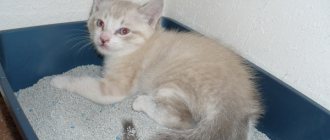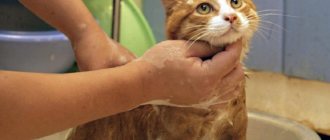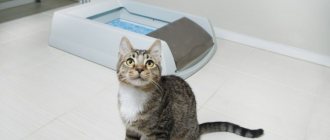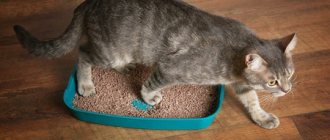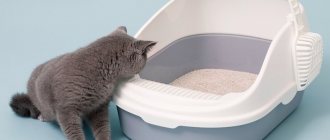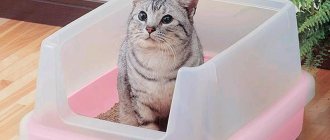“How to train a cat to go to the toilet in a litter tray?” is a fairly common question from pet owners to veterinarians. The topic of training a cat to use a litter box is very popular, despite the fact that there is no need to train a cat to use the toilet.
It is most comfortable for a cat to go to the toilet in a quiet, dark corner, and if you can also bury what you left behind, this is generally an ideal option. And it just so happens that in most apartments, the litter box is by default the most comfortable place for a cat to go to the toilet, so “training a cat to use the litter box” most often equals “choosing a place for toilets for a cat who knows how to do everything herself and will teach anyone you want.” chores that she already needs” (that is, choose the optimal angle for the tray in the house, find a tray and filler that suit the animal).
It is important to understand that if a cat defecates in the wrong place, this often does not indicate that the animal is not accustomed to the litter box, but either that the tray does not correspond to the cat’s ideas about the toilet of her dreams, or that there are existing health problems!
Moreover, urination and defecation in the wrong place never mean that the cat is angry, stupid, offended or taking revenge.
Just as it is important for a person to have privacy and cleanliness for a comfortable trip to the toilet, and it would be extremely uncomfortable physically and psychologically to defecate in the center of the room or in a public place - in the same way it is inconvenient and unpleasant for a cat to relieve itself in a place other than the litter tray, and if she does this, it means something is forcing her to do this.
A cat with unscrupulous behavior needs help, often treatment, but not punishment or training. A cat naturally knows how to go to the toilet in a quiet, secluded place, if this place really is one and if no disease interferes with it.
Unclean behavior is one of the most common problems for which owners consult a behavioral medicine physician.
Conventionally, the reasons for a cat’s unscrupulous behavior can be divided into three groups:
- physical illness (it is painful/uncomfortable for the animal to go to the toilet in general),
- behavioral problem,
- The place provided to the animal for toileting does not correspond to the animal’s own ideas about what a toilet should be like.
Pain
Important! Diagnosis of the cause of any unclean behavior in cats ALWAYS begins with excluding the disease that causes pain and discomfort, that is, from the first group.
This is due to the fact that by rearranging or changing trays and fillers, you can skip the early stage of the disease and lose time and your pet’s health. A physical diagnosis, if there is one, is always more dangerous than a behavioral problem, so diagnosing unscrupulous behavior begins with searching for it.
In addition, if the reason is really pain/discomfort, and the owner, instead of treating the pet, begins to try to solve the behavioral problem/accustom the cat to the litter box (worst of all, if based on advice from other “experienced” cat owners from the Internet), you can do it yourself in addition to the existing physical diagnosis, create an additional behavioral problem that did not exist before!
Take, for example, the most popular advice from Google - “to accustom a cat to the litter box, lock it in a limited space, where there will be nothing but the cat and the litter box; first, out of despair, the cat goes into the litter box, because there is nowhere else to do it, and only for itself, and Over time she will get used to it." And perhaps, in a desperate situation in a limited space, the cat will actually go to the toilet in the tray, because there is nowhere else. Only now, if the reason for her unscrupulous behavior is a physical diagnosis, because of which it is painful for her to relieve herself, then in this way you can fix the “tray = pain” association in the cat’s head for a long time (if not forever), and even after recovery from the underlying disease and relief from pain, the animal may continue to be afraid of the litter box because it used to hurt.
When a cat begins to avoid the litter box, even the most patient and loving owners can become desperate and begin to attribute human qualities to the animal in order to explain the pet's behavior. “She’s taking revenge on me, she’s jealous, she’s capricious, she’s doing this on purpose to annoy me” - these are the thoughts that may appear in the head of a cat owner when they see damaged things.
Before you give vent to your emotions, remember that physical and verbal punishments are additional stress for cats and can not only not improve the situation, but can also cause great harm.
It is necessary to start by finding out the reasons for the cat’s unscrupulous behavior, and discarding all prejudices, let’s list them.
Diseases of the urinary system (cystitis, pyelonephritis, kidney disease, urolithiasis), inflammatory bowel disease, parasitic diseases, colitis - this is not a complete list of diseases that can cause symptoms of unscrupulous behavior.
Your cat may experience discomfort and pain when using the litter box.
Urinating in small portions, the presence of blood in the urine and feces, a prolonged process of urination, increased grooming in the genital area, anxiety before urination/defecation - these are the first symptoms that should alert you.
Until you visit a veterinarian, the problem will not go away, despite the use of anti-gads, pheromones, rearranging trays, changing the tray and filler, and following advice on raising/training a cat to a litter box on the Internet.
It is quite difficult to look for “something that hurts” in a cat based on one single symptom - unclean behavior. Examining an animal “everything” in search of a diagnosis is expensive. And without an in-person examination of a specific animal, it is impossible to name a specific list of diagnostic procedures that must be carried out to make sure that the cause of unscrupulous behavior is not a physical diagnosis. Usually, during the collection of anamnesis and an in-person examination of the patient, the doctor discovers additional symptoms in addition to urination/defecation in the wrong place and, based on the data collected in person, the doctor decides on the need for certain diagnostic measures.
However, all cats without exception who urinate in the wrong place are recommended to undergo a general urine test and, if possible, an ultrasound of the urinary system. This is the minimum necessary to objectively exclude a physical diagnosis from the list of potential causes of unscrupulous behavior.
Diseases of the musculoskeletal system, such as arthrosis and osteoarthritis, especially in older animals, can also provoke unclean behavior if the cat has an uncomfortable tray with high sides and it is painful for her to jump into it.
You should be aware that even after recovery, the problem of unclean behavior may persist if the cat continues to associate the litter box with the place where it was painful. In this case, you should rule out a recurrence of the disease and try changing the tray or filler.
Why does a cat start walking past the litter box?
If we are talking about a small kitten, most likely it is a matter of insufficient training. When the cubs grow up with a trained mother cat, she independently accustoms them to the tray, dragging them to it by the scruff of the neck. If a kitten is separated from its mother at an early age, this care falls on the owner.
How to stop a cat from walking past the litter box
Children are taught this way:
- When your pet has relieved itself, you need to blot a piece of toilet paper with its secretions and place it in a clean tray.
- Then the kitten is tilted as gently as possible to the place where he emptied, and then gently dragged along the floor to the litter box.
This is how the animal begins to associate going to the toilet with a litter tray. Training takes time, but after 4-7 times the cat should go to the litter box on its own.
If an adult cat suddenly stops using the tray or getting into the container, you should be wary. Perhaps he experienced stress, or the body faced an illness.
Health problems
The reason does not always lie in illness. A cat may temporarily stop using the litter box if it becomes stressed. For example, moving, renovation or the appearance of a new animal in the house. It happens that such behavior provokes the birth of a child from the owners.
When your cat walks past the litter box because he can't get into the container, it could be arthritis. Elderly cats suffer from this especially often. The animal becomes limited in mobility and cannot raise or lower its limbs sufficiently.
Important! The most unpleasant reason is the occurrence of genitourinary tract diseases.
One of the symptoms is urinary incontinence. It is necessary to take the animal to a veterinary clinic to undergo urine tests and an ultrasound of the organs. In such cases, treatment with drug therapy is indicated, which significantly alleviates the animal’s condition.
Declawing
Declaw removal is a procedure during which the claw is completely removed along with the first phalanx of the finger. It is performed under general anesthesia, which further increases the burden on the pet’s body.
Important! Declawing is performed solely for the convenience of the owners: to prevent the cat from scratching and damaging the furniture. The animal itself experiences enormous stress from the fact that the body has lost one of its main functions.
Another side effect of the surgery is tenderness in the paws. In fact, they remain open wounds that heal for more than a month. Sometimes painful sensations accompany a cat throughout her life. It is unpleasant for the animal to scratch the litter, and it may be forced to pee on the floor or furniture.
Declaw surgery
Dirty tray
Cats are very clean animals. Even street cats try to relieve themselves in secluded, clean places, burying everything in the ground. Therefore, you should always monitor the cleanliness of the tray and change the filler on time.
Important! If there are several cats in the house, each should have a separate “potty”. Especially if they are same-sex animals.
A convenient solution for toilet cleanliness is special bags for pallets. They are put on the tray and secured to the edges of the tray. The usual filler is poured on top. Thanks to the bags, used raw materials can be easily removed, and the tray itself will not get dirty.
Tray bags
Territory and security
One of the reasons why a cat walks past the litter box is the loss of a sense of security. Cats become very attached to a place, and any changes can cause discomfort for the pet. This often happens when two cats live in the same home and they cannot divide the territory.
For the process of emptying, the pet needs a secluded place where it will not be disturbed by extraneous noises and odors. It is absolutely unacceptable to install a tray in the kitchen, hallway or other places not intended for this purpose, even if there is not enough space in the apartment. In addition, an unpleasant odor will spread into the home, which is difficult to remove. If there really is no space for a litter tray, you can train your cat to relieve himself in the toilet.
Toilet training pad for cats
For reference: the standard tray is placed in the toilet, in the far corner, so that the cat can quietly retire.
However, picky animals may refuse to go there just because they don't like the place. First, you should try placing the tray in different corners, and only if this does not work, in the hallway.
Punishing a cat
Cats, unlike dogs, are not trainable in the classical sense. Therefore, they cannot be punished. After punishment, the animal may develop the following associations:
- the owner causes fear;
- to relieve yourself is to invite problems.
Punishment, especially with violence, will not bring anything good. Over time, your pet will become more aggressive or live in a state of stress. Another solution to the situation will arise in the cat’s head - “piss” when the owner is not around. This is fraught with “surprises” in various unexpected places. One of the reasons why a cat leaves “puddles” is revenge on the owner.
If a cat shits on the bed, sofa or floor, you should experimentally find out the reason, and then begin to wean the animal from the bad habit. Cats usually learn new rules quickly.
Transportation, house change
Cats become strongly attached to territory and, when moving to a new habitat, can change their habits of being clean.
Therefore, try to prepare the animal for moving in advance, minimize stress during transportation, and also try to ensure that the new home has everything necessary: scratching posts, trays, vertical spaces (the ability to jump somewhere high and observe the territory from above), hiding places, bowls with food and water.
Punishing an animal that is stressed will worsen the symptoms and may persist for a long time.
Why does a cat go to the toilet in the wrong place?
A well-bred pet will not break the rules if the cat pees in the wrong place - on the carpet or the owner's bed - there are reasons for this. An attentive owner must first examine the animal, check its physical condition, observe its behavior and mood .
Often the cause of a cat's misdeeds is his illness. If a cat urinates past the litter box, the reason may be lack of attention from humans. Domestic cats can show character; they need communication with a person and care from him. Therefore, before weaning your pet from a bad habit, you need to check the comfort of his life and health.
Sexual behavior
To recognize marking (sexual behavior accompanied by urination), you need to follow the process itself or pay attention to the places in which your pet marks: vertical surfaces on which the cat lifts its tail and leaves small portions of urine - these are marks designed to attract cats of the other sex or demarcate your territory.
Castration and modification therapy when keeping cats in groups can help in this situation to solve the problem of unclean behavior.
Manifestation of character
Why do cats pee in the wrong place if they have never had any health or toilet problems before? We must not forget that these are animals with character, emotional ones .
- Has your cat started shitting in the bed? This may be a form of protest against the indifference of the owners , against the appearance of new pets in the house, even against moving to a new apartment. Feeding, bathing, combing are insufficient manifestations of love; you should also stroke your pet, pick it up, and talk to it affectionately. Even if things are overwhelming or you are not in the mood. In this case, the cat will not pee on the floor near the threshold.
- If a cat goes to the corner after a dog appears in the house, you must not forget about it because of another pet . Love and attention should be shared between two.
INTERESTING! Cats can relieve different “needs” in different places; in this case, you need to purchase two trays so that the animal can comfortably go to the toilet.
Changing Tray or Litter Preferences
Cats are mysterious creatures. Even if a cat has been using the same litter box and litter for many years, its preferences may change with age. Keep the litter box clean; many cats prefer to use only clean litter or have a second litter box for defecation.
If you keep several cats, then the number of trays should exceed the number of cats by one, that is, two cats need three trays (there may be no problems with unclean behavior even if there is one tray for many cats, but this is an exception to the rule and rather means only that these cats endure discomfort).
Pay attention to the location of the tray. Urination is an intimate process and a tray located near a washing machine, repair work, or the front door can scare away the cat.
A strong smell can ruin a cat's relationship with the litter box - an air freshener in the toilet, a new scented laundry detergent in the bathroom, or even the litter box itself, if it is scented.
Why does a cat walk past the litter box: the main reasons and what to do
Sometimes your pet starts shitting past the litter tray. Cat “traces” appear in various corners, under furniture, even on rugs. Kind owners first obediently clean up after their pet, then they lose their temper and start shouting at it and even hitting it.
Often the problem can be solved quite simply if you understand the reason for the pet’s behavior. Has your cat decided to take revenge for something? Calling for help? Or are there any other nuances to this behavior? Let's try to figure it out.
Conflicts with other cats or family members
Surely, you have had situations in your life when you, having seen an unpleasant person on your way, changed your trajectory in the hope of avoiding a collision with him.
A common problem with keeping cats in groups is that the cats did not choose their neighbors, but their owners did. And, unfortunately, our tastes do not always coincide. Sometimes cats have to share a home with animals that they find unpleasant for some reason.
In this case, the cat may experience stress when it is impossible to go to the toilet without colliding with another cat (when, in order to go to the toilet, you need to pass by an unpleasant cat whom you really don’t want to pass), which leads to the manifestation of uncleanliness (it becomes easier to go to the toilet). the toilet is in a different place, where you don’t need to meet the hated furry).
Tiered distribution of cats in the apartment (play complexes with houses and hammocks at different heights), distribution of the required number of trays in different parts of the apartment and modification therapy aimed at reducing stress levels can help cope with this trouble and improve relationships in the cat family.
A cat pees in the wrong place - causes of the problem and methods for eliminating it
There are several reasons why your pet goes to the toilet anywhere. The most difficult of them is animal disease.
- Poor health , weakness, and lack of coordination can lead to the cat being unable to reach its litter box. She pees anywhere, depending on the need. If you pay close attention to your pet, it is not difficult to notice his discomfort. With such an offense, the cat may simply be trying to draw attention to himself and his poor health. The owner must take the cat to the veterinarian to cure the disease. In this case, the problem with the toilet will disappear by itself.
- If a neutered cat begins to pee on the sofa or carpet, this may indicate the body’s reaction to the operation. The cat has gone through a lot of stress and must adapt to a new way of life. A person needs to be patient and monitor whether the wound is healing well. The cat may be in pain.
- Disorders of the genitourinary system are typical for older cats. Old animals cannot control their body; bowel movements occur spontaneously; in this case, you cannot scold or punish your pet. He deserved attentive care and affection, because for a long time he gave so much warmth and affection to the whole family. Special diapers will help solve the problem; you can also periodically take the animal to the tray.
- There are several other health-related reasons why a cat goes to the toilet in the wrong places. The first is the presence of helminths , from which remedies from a veterinary pharmacy help get rid of them. The second is constipation caused by poor diet . It is important to feed your cat lean meat and dairy products. If an animal is prescribed a diet, it must be followed.
Lesions of the central nervous system
Unclean behavior can be a symptom of cognitive disorders - hydrocephalus in kittens, brain tumors and senile dementia (in older animals) or other damage to the cerebral cortex (cyst, ischemic encephalopathy).
In diseases of the central nervous system, there may be convulsions accompanied by involuntary urination. If, after your absence, you can detect urine, saliva and other unknown traces in the cat's resting areas, this may be a sign of seizure activity.
Cat owners may confuse urinary incontinence with unclean behavior (often people do not see, but simply feel that the bed linen smells unpleasant).
Neurological deficits can lead to loss of conscious urinary control (continuous leakage of urine throughout the day or leakage due to an overfilled bladder that the animal cannot empty on its own).
Such diseases begin to be diagnosed only when there are additional symptoms indicating damage to the central nervous system, or when all other possible causes have already been excluded.
How to stop a cat from going to the toilet past the litter box
What should you do if your pet regularly goes to the wrong place to relieve itself? If there are no health problems with the litter box, you need to use proven advice from breeders and experienced cat lovers
- A special spray will wean your cat off the new habit.
- Ordinary vinegar, lemon, iodine, and potassium permanganate often also help to cope with the problem. These products should be used to treat the area where the unpleasant puddle appeared. Strong chemical odors can keep your cat away. Simple detergents, even if you thoroughly wash the floor, will correct the situation for a short time.
You cannot shout at a cat caught at a “crime scene ,” beat it, or poke its nose into a puddle. The animal will get scared, and stress will only make the situation worse. At that moment when the cat pees in the wrong corner, you can drop a few drops of warm water on his head. This method often has good results.
ATTENTION! Using bleach to clean a puddle area is not effective. You can sprinkle this area of the floor with red pepper (in small quantities so as not to cause a burn). Another method is to place double-sided tape on the floor.
It is difficult to retrain a cat if it regularly goes to the toilet past the litter box. You need to be patient and calm so that the animal does not feel aggression during training.
- The house should be regularly wet-cleaned , with great emphasis on cleanliness in the room.
- The litter in the tray should be changed at least once a week , but it is better to do this more often, because cats are sensitive to unpleasant odors and dirt. If you choose a tray that is spacious and high, the animal will feel safe while using the toilet.
- There are special sprays that can correct behavior. They are safe, effective, and work better than screaming and punishment.
- The most difficult situation is when male cats mark their territory with puddles , attracting the attention of the opposite sex. No drugs or training methods will work; it is best to carry out sterilization or castration (if there are no plans to breed kittens).
- The cat walks around the corners because of resentment or lack of attention - you need to show it your love, create comfortable living conditions in the house.
